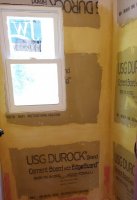Mnchevelle
New Member
Hi all,
I'm new here but have looked at this site many times to help me figure out my problems. I can't thank enough for the information everyone provides. So here's my mission: trying to convert an old pantry off of kitchen into a bath/shower combo. The whole room will be waterproofed and all tile except for ceiling.
I'm a tile guy so that part is easy but plumbing is another story. Can someone check this mock up and see if it will work? I believe it will, but am unsure if I went the easiest route or am way off on something.
There is a floor drain for shower, a toilet and on the stack wall a corner sink. I ran 2" vent all the way up chase which has sink drain then turn into wet vent for shower and toilet before heading back into stack. Here are few pictures let me know what you think.
Thanks.






I'm new here but have looked at this site many times to help me figure out my problems. I can't thank enough for the information everyone provides. So here's my mission: trying to convert an old pantry off of kitchen into a bath/shower combo. The whole room will be waterproofed and all tile except for ceiling.
I'm a tile guy so that part is easy but plumbing is another story. Can someone check this mock up and see if it will work? I believe it will, but am unsure if I went the easiest route or am way off on something.
There is a floor drain for shower, a toilet and on the stack wall a corner sink. I ran 2" vent all the way up chase which has sink drain then turn into wet vent for shower and toilet before heading back into stack. Here are few pictures let me know what you think.
Thanks.













